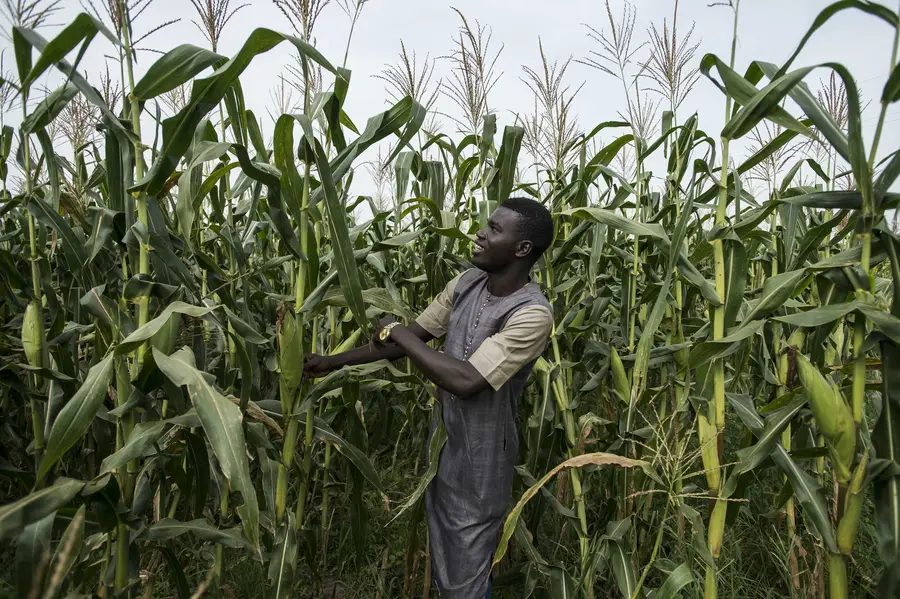
A worker shows a Kamara corn field on September 23 2017, in Niassene, Kaolack region, Senegal. Photo credit: Xaume Olleros / RTI.
The impact of Russia’s war on Ukraine has reverberated to Africa, where it has driven up fertilizer prices and reduced agricultural productivity, resulting in higher food costs. “Green ammonia,” currently under development, has the potential to (1) improve Africa’s fertilizer and food security, (2) facilitate the advancement of renewable energy sources, and (3) help to mitigate climate change.
Currently, about 85 percent of the world’s ammonia is used to make fertilizer in a process dependent upon fossil fuels, particularly natural gas. Russia, which has abundant gas supplies, is the world’s top fertilizer exporter. When the West imposed sanctions to protest Russia’s invasion of Ukraine, Russia halted many fertilizer exports. The war caused global gas and oil prices to rise. Both factors contributed to greater international competition in the already tight fertilizer market, pushing prices sky high. Smallholder farmers in Sub-Saharan Africa, which imports about 90 percent of its fertilizer, were particularly hard hit.
What is green ammonia and how does it work?
In the current production process for ammonia, methane—the primary component of natural gas—is heated with steam and a catalyst to produce a mixture of carbon monoxide and hydrogen. This process, known as steam methane reforming (SMR), accounts for about 90 percent of the carbon dioxide (CO2) generated during manufacturing. The hydrogen is then mixed with nitrogen at elevated temperature and pressure and converted to ammonia in the Haber-Bosch process.
The current production of ammonia is responsible for nearly twice the greenhouse gas (GHG) emissions as steel production and four times that of cement, which makes it unsustainable. In the future, the world will need more ammonia as fertilizer demand grows, but with fewer emissions to meet the GHG net zero target.
Green ammonia is produced from clean energy sources, not fossil fuels, meaning it is a renewable and carbon-free resource. To reduce the carbon footprint of ammonia production, the SMR process is replaced with electrolysis, which uses electricity to split water into oxygen and hydrogen. If the electricity is generated from renewable sources, the resulting hydrogen is also considered renewable and CO2-free. Green ammonia offers cushioning from such market and geopolitical shocks because it is made from renewable resources like water—possibly even seawater in regions where fresh water is limited—and can be produced using alternative energy sources, including wind and solar.
Decoupling fertilizer production from natural gas and other fossil fuels will reduce GHG emissions and keep costs down, improving the affordability of this crucial agricultural input for Africa’s smallholder farmers and its availability via local and regional sources.
Decreasing fertilizer imports and increasing local production
Synthetic fertilizer produced through the Haber-Bosch process helped launch the Green Revolution, which employed a series of technology transfers to expand grain production between 1950-84, reducing famines in Latin America and many parts of Asia. However, due to various factors, including limited regional availability of synthetic fertilizers, the Green Revolution didn’t produce the same dramatic increase in crop yields in Africa. The continent still experiences a high level of hunger and food insecurity.
African farmers use less fertilizer than most farmers in Asia, South America, and the Global North and experience significantly lower crop yields. In a bid to increase production to feed the continent’s rapidly growing population and reduce food imports, the 2006 African Union Declaration on Agriculture set the goal of increasing fertilizer use from the eight kilograms typically applied per hectare to 50 kilograms.
African nations could improve food security while building resilience to shocks like Russia’s war in Ukraine by producing or importing green ammonia, which could be mixed with other substances to manufacture its own nitrogen fertilizer. Green ammonia offers an opportunity for Africa to experience the higher crop yields associated with fertilizer use, without the GHG impacts.
Green ammonia can drive low-carbon economic growth
Green ammonia supports clean energy and climate goals across Africa, where many countries have significant potential to develop or expand renewable energy sources. Kenya, for example, generates over 90 percent of its energy from renewable sources and is the world’s largest geothermal producer in Africa. Kenyan President William Ruto recently announced a new green hydrogen project with the European Union that will leverage its abundance of renewable energy for green hydrogen ventures.
Renewable sources could support both the ammonia industry and incentivize the production of clean power. That’s because green ammonia can be stored, functioning like a giant battery when it’s needed to balance an electrical grid powered by intermittent sources, such as wind and sun, and replacing the fossil fuel typically used for that purpose. With the proper storage infrastructure and electrical grid in place, green ammonia can thus reduce GHG emissions and support the steady supply of electricity needed to drive economic growth.
New technologies can advance green ammonia production
Green ammonia is poised to usher in a new and different green revolution—one that offers real hope for both slowing global warming and meeting Africa’s food and energy needs. We are collaborating with our international partners to explore ways that innovative technologies can advance the adoption of green ammonia in African nations hard-hit by volatile fertilizer markets. Through these collaborations and our pilot scale real world demonstration, we are thoroughly evaluating these different technologies and the most appropriate locations for their development.
By working collaboratively, and transferring technology where appropriate, we can identify and implement the best solution for each region.
Learn more about RTI’s engineering innovations that address the climate crisis.

